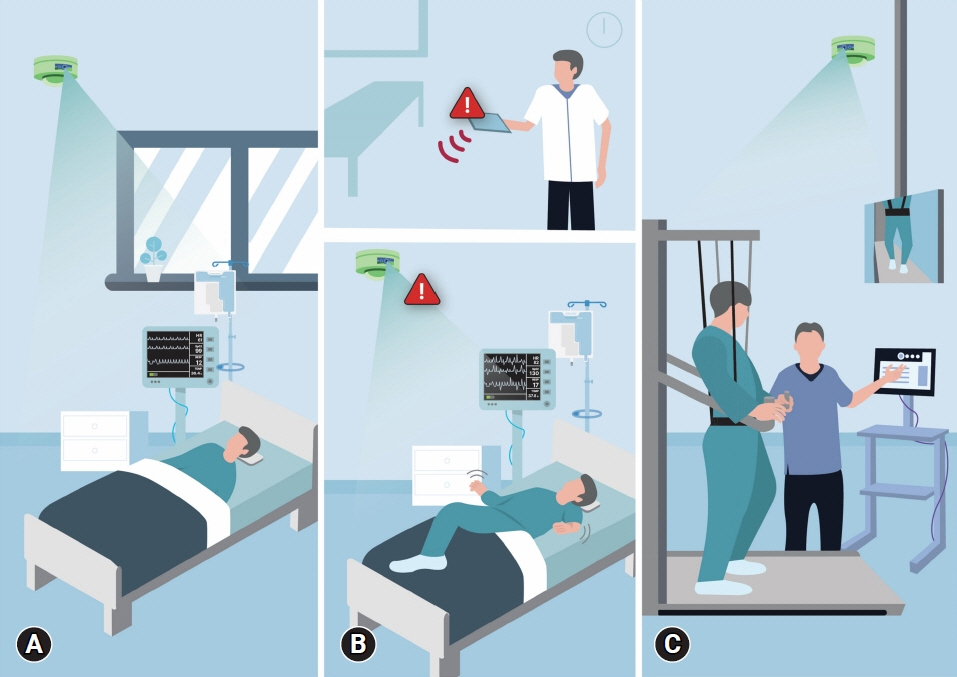J Yeungnam Med Sci.
2024 Jan;41(1):53-55. 10.12701/jyms.2023.01144.
The applicability of noncontact sensors in the field of rehabilitation medicine
- Affiliations
-
- 1Department of Physical Medicine and Rehabilitation, Yeungnam University College of Medicine, Daegu, Korea
- 2Department of Internal Medicine, Yeungnam University College of Medicine, Daegu, Korea
- 3Department of Orthopaedic Surgery, Yeungnam University College of Medicine, Daegu, Korea
- KMID: 2551335
- DOI: http://doi.org/10.12701/jyms.2023.01144
Abstract
- A noncontact sensor field is an innovative device that can detect, measure, or monitor physical properties or conditions without direct physical contact with the subject or object under examination. These sensors use a variety of methods, including electromagnetic, optical, and acoustic technique, to collect information about the target without physical interaction. Noncontact sensors find wide-ranging applications in various fields such as manufacturing, robotics, automobiles, security, environmental monitoring, space industry, agriculture, and entertainment. In particular, they are used in the medical field, where they provide continuous monitoring of patient conditions and offer opportunities in rehabilitation medicine. This article introduces the potential of noncontact sensors in the field of rehabilitation medicine.
Keyword
Figure
Reference
-
References
1. Edanami K, Kurosawa M, Yen HT, Kanazawa T, Abe Y, Kirimoto T, et al. Remote sensing of vital signs by medical radar time-series signal using cardiac peak extraction and adaptive peak detection algorithm: performance validation on healthy adults and application to neonatal monitoring at an NICU. Comput Methods Programs Biomed. 2022; 226:107163.2. Hegde C, Su J, Tan JM, He K, Chen X, Magdassi S. Sensing in soft robotics. ACS Nano. 2023; 17:15277–307.3. Wang J, Warnecke JM, Haghi M, Deserno TM. Unobtrusive health monitoring in private spaces: the smart vehicle. Sensors (Basel). 2020; 20:2442.4. Yaroshenko I, Kirsanov D, Marjanovic M, Lieberzeit PA, Korostynska O, Mason A, et al. Real-time water quality monitoring with chemical sensors. Sensors (Basel). 2020; 20:3432.5. Hall T, Lie DY, Nguyen TQ, Mayeda JC, Lie PE, Lopez J, et al. Non-contact sensor for long-term continuous vital signs monitoring: a review on intelligent phased-array Doppler sensor design. Sensors (Basel). 2017; 17:2632.6. Henke AM, Billington ZJ, Gater DR Jr. Autonomic dysfunction and management after spinal cord injury: a narrative review. J Pers Med. 2022; 12:1110.7. Kim D, Cho M, Park Y, Yang Y. Effect of an exercise program for posture correction on musculoskeletal pain. J Phys Ther Sci. 2015; 27:1791–4.
- Full Text Links
- Actions
-
Cited
- CITED
-
- Close
- Share
- Similar articles
-
- Intraocular Pressure Difference With and Without Soft Contact Lenses by Noncontact Tonometry
- Clinical Evaluation of A Noncontact Applanation Tonometer
- Digital Therapeutics for the Musculoskeletal Disorders
- Intraoperative electrical burn caused by stainless tube tree with noncontact electrosurgical ground: A case report
- Influence of Central Corneal Thickness Change on Intraocular Pressure Measurement after LASIK and LASEK


